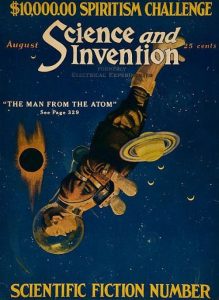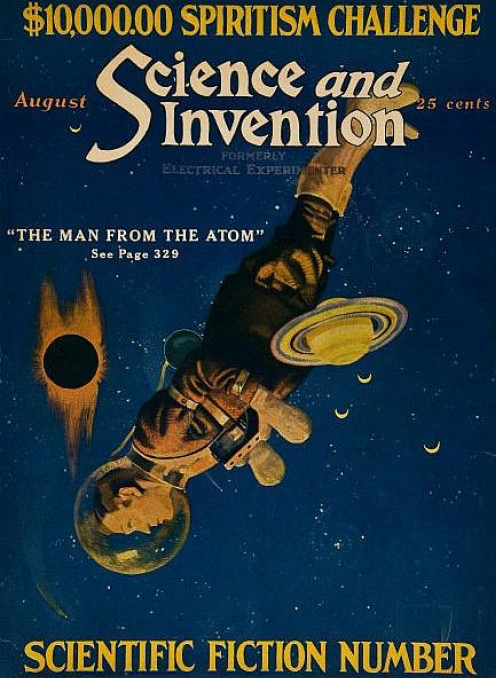 Called “The Barnum of the Space Age” by Life magazine in 1963, Hugo Gernsback emigrated to the United States in 1904. Soon thereafter, he founded a company to import electrical equipment and began producing a catalog. By 1908, Gernsback’s catalog had evolved into his first magazine, Modern Electrics, selling for ten cents. Three years later, his magazine began to publish fiction, serializing Gernsback’s novel about one of the leading scientists of the year 2660, “Ralph 124C 41+.” Considered to be one of the worst novels published in the history of science fiction, Gernsback’s tale must have struck a cord with readers. Not long after its conclusion in the March 1912 Modern Electrics, fiction became a regular feature in the magazine’s pages and subsequent Gernsback releases.
Called “The Barnum of the Space Age” by Life magazine in 1963, Hugo Gernsback emigrated to the United States in 1904. Soon thereafter, he founded a company to import electrical equipment and began producing a catalog. By 1908, Gernsback’s catalog had evolved into his first magazine, Modern Electrics, selling for ten cents. Three years later, his magazine began to publish fiction, serializing Gernsback’s novel about one of the leading scientists of the year 2660, “Ralph 124C 41+.” Considered to be one of the worst novels published in the history of science fiction, Gernsback’s tale must have struck a cord with readers. Not long after its conclusion in the March 1912 Modern Electrics, fiction became a regular feature in the magazine’s pages and subsequent Gernsback releases.
In the spring of 1913, Gernsback began publishing a new science periodical, The Electrical Experimenter. Before long, the magazine was serializing its publisher’s “Baron Münchhausen’s New Scientific Adventures,” a series of fictitious tales set on Mars, the Moon, and elsewhere. These were soon joined by George Frederic Stratton’s stories about an entrepreneur who invested in a variety of intriguing inventions, Thomas Benson’s “Wireless Wiz” yarns, and Charles S. Wolfe’s stories about a scientific detective named Joe Fenner. With its August 1920 number, The Electrical Experimenter was renamed Science and Invention and fiction became a larger portion of its contents. The fiction that Gernsback published in his science magazines generally revolved around a scientific principle. Clement Fezandié’s Doctor Hackensaw stories for Science and Invention are prime examples of this type of story.
In early 1923, perhaps in an effort to boost circulation of Science and Invention or to test the waters in the growing market for specialized fiction magazines, Gernsback began publishing more stories and fiction that was meant to entertain including works by H. G. Wells, George Allan England, and Ray Cummings. Later that same year, Gernsback released a “Scientific Fiction Number” of his science magazine. The August 1923 issue of Science and Invention featured six “scientifiction” stories. It would not be long before Hugo Gernsback would found the first science-fiction magazine, Amazing Stories.
Modern Electrics became a magazine in April 1908. It was published by Hugo Gernsback until he sold it in 1913. The last Gernsback issue was dated March 1913.
Gernsback launched The Electrical Experimenter with its May 1913 number. Its title was changed to Science and Invention with its August 1920 issue. The last Gernsback issue was dated April 1929 when Gernsback lost control of the magazine following bankruptcy proceedings filed against his publishing company.
To learn more about the image used in this post, click on the illustration. Click here for references consulted for this article.






